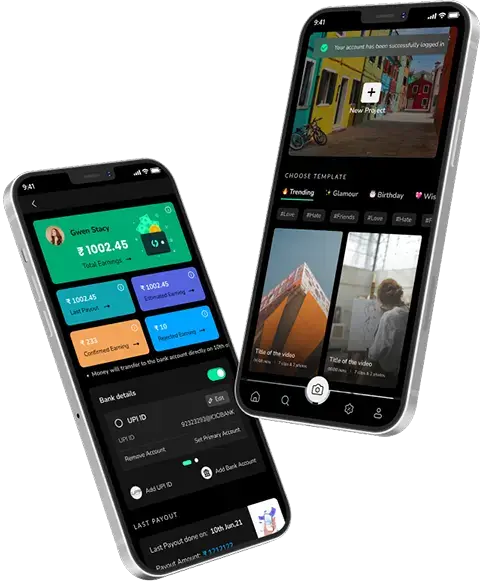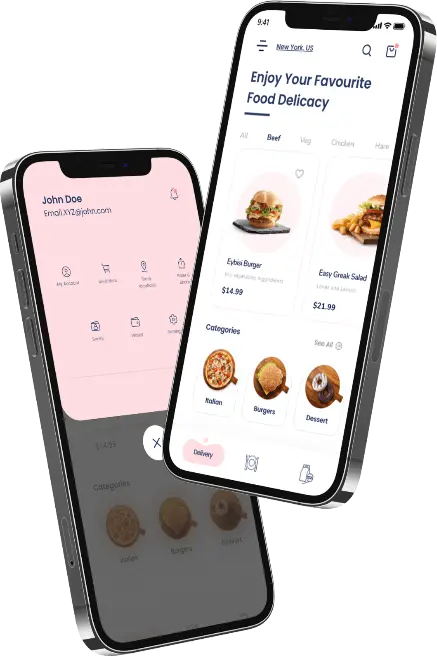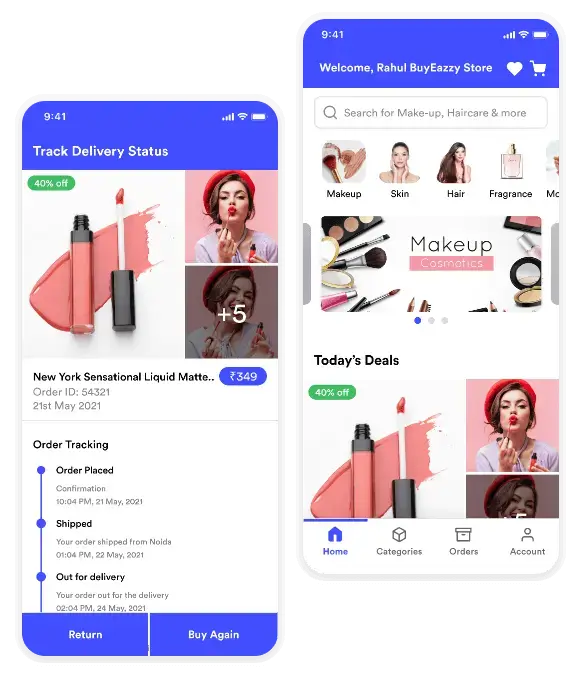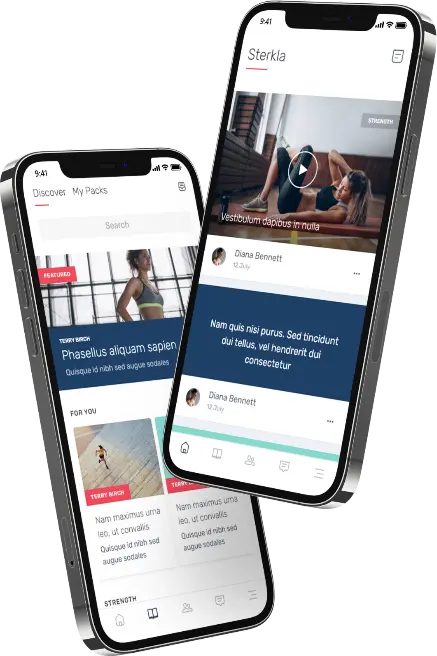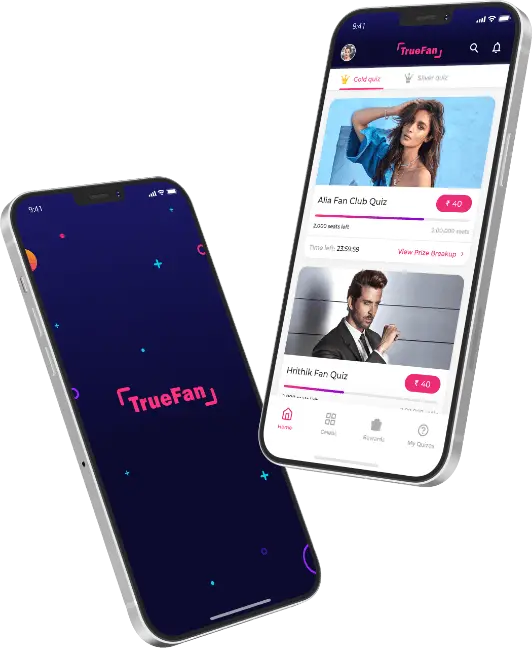15 Dec 2022
Updated on December 27th, 2022
Augmented Reality App Development is All Set to Rule 2023: This Guide Will Help!
Surbhi Bhatia

Although AR apps may seem like a fantasy to some users, they are a source of competitive edge and a transformational application for corporations such as Target and IKEA. It is redefining user experience in e-gaming, e-commerce, training, and development. Furthermore, its acceleration in the global marketplace has led to more technopreneurs and startups investing in AR app development. This article will provide comprehensive insight into the Augmented Reality market and how to build an AR app.
AR Market: What Can The Statistics Say About Augmented Reality Apps’ Future?
These are the numbers that entrepreneurs should use augmented reality to grow their organizations.
According to Statista, there are approximately 1.7 billion users of mobile AR worldwide.
Market share for augmented realities is expected to increase dramatically. Moreover, this market incorporates primary segments such as software and hardware.
The AR market size was approximately. 9.53 billion US dollars. According to Statista, researchers expect a significant shift in the market. It is expected to rebound to 13 billion USD by 2023 and nearly double to 26 billion USD by 2025 (Statista).
What’s more? Snapchat is a social media platform that uses AR in its technical architecture. It has 332 million active users daily (Statista).
Another great example is Pokemon Go, a top-notch augmented reality application that has been downloaded 14.4 million times worldwide as of 2023 (Statista).
Augmented Reality: How does it work?
- Augmented Reality is a category that focuses on devices with integrated cameras, including smartphones, tabs and smart glasses with AR software. You can activate AR by simply pointing the device at an object. The software will analyze the video stream and detect it using computer vision technology.
This 3 step guide will help you understand AR.
- With tools like a camera or sensors, the gadget stores the user’s environment.
- AR objects are determined by using software processes data.
- This is how the AR mechanism works in real-time.
AR can also collect the following information from users, in addition to their smartphones.
- Depth sensors
- Accelerometers
- Cameras
- Gyroscopes
- Light sensors
Types of Augmented Reality Apps
- There are a number of AR apps, including superimposition AR solutions, marker-based AR solutions, markerless AR solutions, location-based AR solutions, and marker-based AR applications.
1. AR MARKER-BASED
These apps use a specific ‘marker,’ such as a QR code, or another image. The marker is used to place 3D content within the app. The PlayStation 3 Wonderbook is an older example of marker-based AR. This gaming peripheral allows users to view a spellbook on their screen, giving space to customer satisfaction. When the player picks up the device, the book moves and rotates. The AR content is displayed by the camera using the patterns in the book. Notably, this technology is used on Instagram and Snapchat.
2. MARKERLESS AR
In place of using codes or set patterns to trigger content, markerless AR uses a camera to detect the environment and motion sensors to place 3D objects on surfaces. This usually involves multiple innovative technologies integrated such as:
- GPS and other location tools
- Digital compass
- Camera
- Gyroscope and Accelerometer
- Depth sensors
The latest devices have depth-sensing hardware (LiDAR and ToF), which improves precision. Markerless AR is powered by depth sensors and other positioning information, as well as ML algorithms. This enables the more precise rendering of 3D content and creates the illusion that digital objects are part of the real world. Pokemon Go uses markerless AR.
3. AR LOCATED
AR apps can display accurate virtual content by capturing the location of users. This is how location-based AR functions. Developers can display objects in geographic space instead of displaying them in relative space. Users can interact with the objects by observing and interacting with them.
Technology-wise, location-based AR is based on GPS, a digital compass and an accelerometer. There are many ways to reduce the distance between the device and its location.
– BLE beacons (Bluetooth Low Energy)
– VPS (Visual Positioning System)
– Wi-Fi Direct Low Range
– UWB, Ultra-WideBand
4. SUPERIMPOSITION AR
This AR type amalgamates digitally, replacing or superimposing an object on top. Superimposition AR could refer to an app that allows you to digitally alter the color of your couch. This is useful for demonstrating cause and effect. A user could point a camera at a city area to see how it looked ten years ago using an archive of Google Maps.
The key benefits of creating an augmented reality app
AR software development is an exceptional idea that can be used in many industries offering efficient customer solutions. AR technology isn’t just for gaming anymore, according to a report. Different types of businesses today are using AR technology, and this trend will continue.
Let’s take a look at the key benefits of AR applications.
1. Boost customer experience
AR technology can give your customers unique reality experiences, which increases their engagement with your products and services. AR technology allows shoppers to virtually try on clothes, homes, jewelry, make-up, cars and other furniture.
2. Sales increase
Reality developers fabricate exceptional AR solutions that also boost sales and income.
3. Performance improvements for your business
AR technology can be used to empower B2B and B2C companies, increasing their efficiency. AR can be used by the construction and automobile industries to visualize and design cars and buildings, before embarking on a full-fledged project. This allows businesses to be more efficient and avoid overpaying and reworking.
4. Monitor the target audience
AR technology gives you access to detailed analytics that allow you to better understand your customers and their behavior. This will allow you to understand your target audience’s preferences, needs, and tastes.
You can see that AR is transforming the way businesses work. Statista predicts that the AR and VR market worldwide will be worth $296.9 Billion U.S. Dollars by 2024.
Also Read: How Augment Reality Solutions Are Benefiting Advertising Campaigns?
Things to Think About When Building an Augmented Reality App
Are you ready to create an AR app? These are four important points to keep in mind.
1. Choose the right AR app development tools
This table lists the top AR app development tools, ratings, and features. It also includes platform support to help you make your app development process a seamless one.
2. Conduct in-depth market research
Market research can help you clarify many questions in the app development phase. These are the steps to help you do better market research.
- You can find similar apps in the Google Play Store and App Store. To check the features of similar apps and to create a list of areas for improvement, download them.
- You can compare the UI/UX, performance and features of AR apps to ensure that your app offers a great user experience.
3. Set your requirements in-line
Next, gather requirements after conducting market research. These are the requirements for app development.
- Features that are to be included
- You can choose whether you want to make a native or hybrid mobile app.
- Choose from iOS, Android, or AR platforms to choose the app development platform
4. Define the proper development process
Decide whether to hire an AR app developer company or a group of AR app developers to work on your project. Once you have made your decision, communicate with them about your needs and agree on a cost.
Before you start the development, make sure that you have cleared up any doubts with your team. To avoid confusion, ensure that you keep the central communication channel.
After we have covered the process of AR development, let’s now look at the different types of AR applications.
Industrial Applications of Augmented Reality
These are just a few examples of how augmented reality is being used in 8 different business sectors.
- Healthcare – Providing better patient experiences during counseling and therapies
- Tourism – Translation and interpretation of signboards at remote locations
- Real Estate – Enhance your home buying and makeover experience
- Education – AR-enabled apps for medical training and program development
- Gaming – Interaction between the real and virtual worlds via simulations
- Retail and ecommerce – enhanced shopping experience through virtual try-on
- Automotive – Fully digital showrooms for vehicle sales and display
- Design modeling and Architecture – Automated, real-time changes to floor plans and engineering design
Augmented Reality App Features to Consider
Let’s take a look at the key features of augmented reality applications before we start to develop them.
1. AR app content
Augmented reality content refers to computer-generated data that enriches the real world by adding digital content via smartphones and tablets and enhances customer engagement. AR content is typically composed of 3D models but can also include visual, audio, and video formats.
Depending on the type of your app, you may have different 3D content. AR app development usually includes the following:
- Create 3D environments for a realistically rendered background
- Text, images, and 3D models can be superimposed. You can insert labels or change colors to make the content more real-life-like.
- To make the experience more real, use an intuitive audio effect
- Provides real-time direction to ensure a great user experience
IKEA, for example, allows customers to test 3D furniture in their homes before purchasing it.
2. Push notifications
Push notifications allow you to communicate with your users about important information such as updates, sales, special offers, or other useful information. These messages are sent to your users and stimulate engagement. They also accelerate conversion rates and brand consistency.
3. QR code scanner
This feature allows users to interact with the real world. For example, people can scan QR codes with their smartphones to add an extra dimension to their products.
4. Register/user account
Sign up to use your mobile app. Users can register and create an account to get started with AR.
5. Social media sharing
Social media app integration allows users to share content with others. This content spread will allow you to attract more people, who may then become your regular users. You can then run an effective advertisement and grow your business.
5 Steps to Make an Augmented Reality App
Let’s take a look at the five steps involved in building an AR app.
1. Select the Type of AR App You Would Like to Build and Launch
Your business needs will determine the type of augmented reality app you choose to launch.
Startups are likely to want to create a new app using this futuristic technology. You can fill a gap in the market with AR integrations, or support an existing business area that does not have AR integrations. Or, simply create an AR-supported game.
If your business is established, then you will most likely be looking for an AR solution to boost sales and marketing efforts. Take a look at Target and IKEA Place’s examples. You can add AR-specific features to an existing business app that you have for customers.
2. Note the features you want to add
The total functionality of your AR app will depend on what you want to offer, but here are the top five features you need in an augmented reality digital solution.
– GPS detection and map Integration
– Built in camera function – to capture or scan real environments
– Marker recognition – It detects images, icons, QR codes etc.
Library of 3D visuals, text elements
Sign up guest and share your social media posts
3. Select a Tech Stack and Create a Development Strategy
After you have identified the features you wish to include in your app, it’s time to choose the right technology stack and tools for your digital product. Different features will require different levels and support.
Augmented Reality apps require a solid programming architecture. This is especially important in the back-end, and these apps can monitor real environments and place virtual objects.
AR development also requires specific frameworks and software tools – most of which are not open-source or free. Thus, they can be costly. It is important to choose a tech stack with care, as it can be a cost-center. These are the four things you should consider when selecting a tech stack.
– Your AR app’s size and target audience.
– Your plans for scaling your AR product or company in the future
– Estimated AR app development budget
4. Hire an AR App Developer and Conclude Technical Milestones
This is the A team that will help you during and after development. A smaller team will be needed if you have a technical background in, for example, app coding or AI programming. On the other hand, if you come from a business background, and are not proficient in programming, a reliable mobile app development company is what you need.
– The selection of the right human resources is an important cost center for this project. You need to consider the work and operational arrangements of your team in order to optimize your costs.
Full-time wages and benefits make it very costly to hire an in-house staff.
– Hire a development team to work on an hourly basis. This is a new way of managing staff augmentation and allows for full control and flexibility over project timelines.
– Outsourcing your entire app development project is a common option. You can monitor the progress remotely and have it completed, tested, and launched on time.
5. Get the Augmented Reality App and Launch Your Product
This is the last step before your app can be downloaded and used by your target audience. The key to ensuring the app’s success is battle-testing it.
AR app developers usually follow three standards to test and assess the quality of any mobile app:
Technical performance: QA specialists assess the app’s backend and front-end. They make sure the app runs smoothly on all platforms and screens.
Navigation and user experience: This stage is where testers ensure that the app’s user journey is minimal and that it is easy to use for all users. This test is important for app loading speed, sign up, sign in, and other features. It also checks graphic stability.
An app can only be trusted to protect your data. The ethical hacking process is performed by penetration testers to ensure that the app doesn’t become a victim to data breaches or leak sensitive user information. Another part of the test evaluates whether an app can return accurate answers. These AR apps respond by accurately recognising text, images, locations, and environments.
These types of testing are known as functional testing, instrument and unit testing in technical terms.
After the app has been tested, clients can approve it. After the app is tested, it’s ready to be deployed and launched in the store
Once you have identified the functionality required, we can now consider which tech stack should be used to create these features. Our experts share technologies and tools that will help you create reliable, stable custom AR software.
- Vuforia
- ARToolKIt
- Google ARCore
- Apple ARKit
- Maxst 3D
- Wikitude
Augmented Reality Mobile App Development Challenges
Have a look!
1. Verification of product viability
A solid foundation is essential for creating a great app that’s in high demand. Before you begin an augmented reality development project, it is important to define your target audience and consider their goals. Finally, decide how your AR app will help them.
2. App design and AR content creation
AR app development requires not only expertise in mobile UX/UI design, branding, but also 3D artists with image processing abilities. They may need to create animated images, or 3D models depending on the app. These can be used to project real-world objects and environments. Our clients and we can minimize development risks and avoid rework by creating 3D models.
These are some of the things to keep in mind when designing an AR mobile application:
– Onboard new AR users. Use these step-by-step tips and tricks to show off all the useful features.
Avoid lengthy session times as your users will have smartphones in their hands.
– Do not overcrowd your camera view with unnecessary components. Remember that the camera is your primary UI element so keep it simple.
Safety is important as users can get distracted easily and face real-life dangers when using AR apps. Send protection notifications and consider safe routes.
3. Selecting a trusted tech partner
You might not have been able to find a reliable and skilled tech partner before that. It is crucial that you choose a partner who understands your business goals and offers relevant solutions. They also keep their promises.
Techugo is a top augmented-reality app development company at its best!
It is easy to find an augmented-reality app development company by using trusted platforms such as Clutch or IT Firms, GoodFirms or TopDevelopers, where IT vendors can share information about their services . These platforms allow you to view the tech stack of an outsourcing company, their rates, reviews, and other information. You can also find your ideal augmented-reality app developers.
A Nutshell!
Businesses from many industries have realized the immense benefits of augmented reality and virtual reality.
AR technology is a great tool for companies of any size to increase interaction with customers, create emotional connections with them, enhance the promotion of products and services, increase conversions, boost efficiency of employees, improve product quality and increase productivity. AR-enriched products can help you gain competitive advantage.
We are happy to assist you in creating an AR mobile game or app. Contact us to create an authentic experience for your users.
Get in touch.
Write Us
sales@techugo.comOr fill this form


